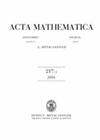Foliated corona decompositions
IF 6.7
1区 数学
Q1 MATHEMATICS
引用次数: 16
Abstract
We prove that the $L_4$ norm of the vertical perimeter of any measurable subset of the $3$-dimensional Heisenberg group $\mathbb{H}$ is at most a universal constant multiple of the (Heisenberg) perimeter of the subset. We show that this isoperimetric-type inequality is optimal in the sense that there are sets for which it fails to hold with the $L_4$ norm replaced by the $L_q$ norm for any $q<4$. This is in contrast to the $5$-dimensional setting, where the above result holds with the $L_4$ norm replaced by the $L_2$ norm. The proof of the aforementioned isoperimetric inequality introduces a new structural methodology for understanding the geometry of surfaces in $\mathbb{H}$. In previous work (2017) we showed how to obtain a hierarchical decomposition of Ahlfors-regular surfaces into pieces that are approximately intrinsic Lipschitz graphs. Here we prove that any such graph admits a foliated corona decomposition, which is a family of nested partitions into pieces that are close to ruled surfaces. Apart from the intrinsic geometric and analytic significance of these results, which settle questions posed by Cheeger-Kleiner-Naor (2009) and Lafforgue-Naor (2012), they have several noteworthy implications, including the fact that the $L_1$ distortion of a word-ball of radius $n\ge 2$ in the discrete $3$-dimensional Heisenberg group is bounded above and below by universal constant multiples of $\sqrt[4]{\log n}$; this is in contrast to higher dimensional Heisenberg groups, where our previous work showed that the distortion of a word-ball of radius $n\ge 2$ is of order $\sqrt{\log n}$.叶片状电晕分解
我们证明了$3$维Heisenberg群$\mathbb{H}$的任何可测量子集的垂直周长的$L_4$范数至多是该子集(Heisenberg)周长的泛常倍数。我们证明了这个等周型不等式是最优的,因为对于任何$q<4$,都存在它不能成立的集合,其中$L_4$范数被$L_q$范数取代。这与$5$维度设置形成对比,在该设置中,$L_4$范数被$L_2$范数替换,上述结果成立。上述等周不等式的证明引入了一种新的结构方法,用于理解$\mathbb{H}$中曲面的几何。在之前的工作(2017)中,我们展示了如何获得将Ahlfors正则曲面分解为近似内在Lipschitz图的片段的层次分解。在这里,我们证明了任何这样的图都允许叶化日冕分解,这是一个嵌套划分为接近规则表面的块的家族。除了这些结果的内在几何和分析意义(解决了Cheeger Kleiner Naor(2009)和Lafforgue Naor(2012)提出的问题)之外,它们还有几个值得注意的含义,包括在离散的$3$维海森堡群中,半径为$n\ge2$的单词球的$L_1$失真上下由$\sqrt[4]{\logn}$的通用常倍数定界;这与高维海森堡群形成了对比,在海森堡组中,我们之前的工作表明,半径为$n\ge2$的单词球的失真为$\sqrt{\logn}$阶。
本文章由计算机程序翻译,如有差异,请以英文原文为准。
求助全文
约1分钟内获得全文
求助全文
来源期刊

Acta Mathematica
数学-数学
CiteScore
6.00
自引率
2.70%
发文量
6
审稿时长
>12 weeks
期刊介绍:
Publishes original research papers of the highest quality in all fields of mathematics.
 求助内容:
求助内容: 应助结果提醒方式:
应助结果提醒方式:


